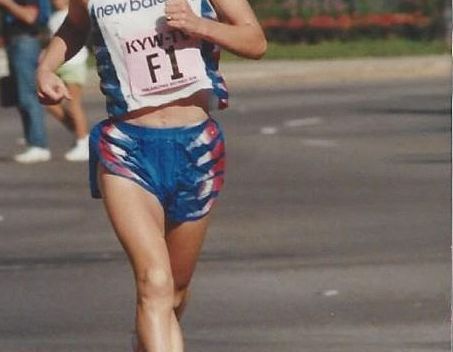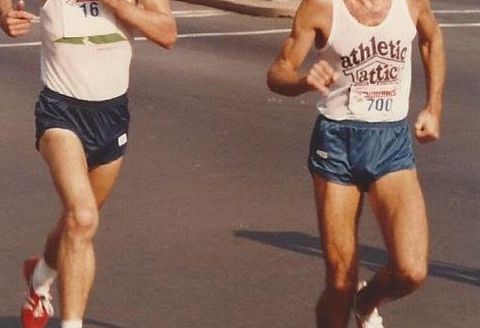When runners sign up for a race, they expect to check one of two boxes. Competitors will race in one of two gender divisions, and winners will receive prize money from one of two pools. Race divisions split between the gender binary—male or female—is a norm that most runners expect, and few have challenged.
Yet in the fall of 2021, the Philadelphia Distance Run (PDR) plans to do just that.
The PDR will be the first road race in the U.S. to establish a nonbinary division all the way up to the elite level, with equal prize money awarded to winners of the male, female, and nonbinary categories. The PDR organizers hope that establishing a nonbinary division will set a precedent for gender inclusion in the running community.
What happened to the original Philadelphia Distance Run?
From 1978 until 2009, hordes of runners clad in pastel shorts and singlets flooded the streets of downtown Philadelphia for the popular Philadelphia Distance Run. In the race’s inaugural year, right at the start of the first running boom, it boasted a field of 3,400 runners—at the time, that was a huge amount of runners for a first-time race.
The race, beloved by amateurs and elites alike, continued to pick up popularity, and the field size grew larger over the next three decades. Seven half marathon world records were set at the race, including 1:08:34 by Joan Benoit Samuelson in 1984, and 1:00:46 by Dionicio Ceron in 1990.
But in 2010, the event was bought by Competitor Group Inc. and rebranded as the Rock ‘n’ Roll Philadelphia Half Marathon. Despite the change, the race continued to grow, one year achieving a field size of 20,000 runners. In the 2011 race, both Matthew Kisorio (58:46) and Kim Smith (1:07:11) ran the fastest half marathon times on American soil at the time. But after that year, the course record wasn’t broken again.
The name and ownership change lasted until August 12, 2020, when Competitor Group Inc. announced that they would be cancelling the race for 2020 and 2021, due to the COVID-19 pandemic. Then, the rights defaulted to the original directors of the PDR.
Within hours of reading the announcement, three Philadelphia running community leaders connected over a conference call, discussing their hopes to revive the historic race. When they presented their plan to the original directors of the PDR, all parties agreed: the three community leaders would serve as the new race directors. Ross Martinson, owner of Philadelphia Runner; Ryan Callahan, president of Runhouse; and Andy Kucer, Executive Director of Student’s Run Philly Style, hoped to not only revive the PDR to the iconic event it once was, but to place equity and inclusion at its core.
Establishing a nonbinary division
The first thing Kucer did was reach out to C.C. Tellez, director of LGBTQ+ programming at Students Run Philly Style, for suggestions on how to make the event more inclusive for LGBTQ+ athletes. In 2013, Tellez founded Lez Run, a Philadelphia running team aimed at providing LGBTQ+ athletes with a safe and supportive running space. Tellez wanted these athletes, many of whom identified as transgender or nonbinary, to feel welcome in places that expanded beyond the team’s weekly runs, so in 2018, she and the Lez Run board began reaching out to local race directors, asking for nonbinary divisions.
Some local races—the DVLF’s FundRACE 5k, HOPE Nation STOMPS Cancer 5k,
Students Run 20k, Rundiscover Philadelphia, and Harvest Run 5k and 10-mile run—agreed to implement a nonbinary or “no gender” category, but none of these races had elite divisions. When Tellez reached out, on behalf of Lez Run, to larger Philadelphia-area races, namely the Broad Street Run and the Philadelphia Marathon, those race directors never replied.
A spokesperson from the Philadelphia Mayor’s Office, in charge of both races, told Runner’s World that the city has not confirmed either event will happen in 2021. If the races happen, the city would not be able to implement a nonbinary division this year, due to logistical challenges, but would consider it for future races.
So when Kucer reached out, Tellez immediately suggested implementing a nonbinary division in the PDR, all the way up to the elite level.
“When we imagined an elite nonbinary division, we imagined it would be years and years in the future. We were struggling to just see this change at the local level,” Tellez told Runner’s World.
Martinson, Callahan, and Kucer confirm that implementing a nonbinary division is really not that complicated; it takes little time to add additional gender options to a registration form, and all potential sponsors have been supportive of the new division. Still, the race directors budgeted for prize money for the nonbinary division as soon as it entered the discussion, certain that they could make it work, whether or not they had a sponsor behind it.
“Nonbinary inclusivity is a human right, and I believe that a lot of people in the racing industry agree with that sentiment,” Callahan told Runner’s World. “But most race directors and organizers just throw their hands up and say, ‘it’s too complicated.’”
In 2013, Lauren Lubin—author, former Division I athlete, and producer of the We Exist: Beyond the Binary film—approached the directors of the New York City Marathon, asking for a nonbinary division, but they didn’t make it happen. Lubin, who uses they/them pronouns, became the first openly nonbinary athlete to run the NYC Marathon, in 2016; still, when registering for the race, they had to choose between the male or female category.
“There is so much fear around inclusion,” Lubin told Runner’s World. “There are so many real threats to women’s sports—from equal pay to the protection of Title IX. Trans and nonbinary folks are not one of them.”
In the spring of 2021, New York Road Runners’ (NYRR), the entity in charge of the NYC Marathon, started including “non-binary” as a gender choice for athlete profiles, and starting on June 26, 2021, NYRR race results will display three divisions. However, it remains unclear whether elite nonbinary athletes will receive prize money at NYRR events.
Why is this significant?
Some might argue that races don’t explicitly exclude nonbinary athletes. After all, Lubin registered for the NYC marathon as female, the gender they were assigned at birth. So, why is it necessary to include a specific, nonbinary division?
“This is your identity,” Tellez said. “We, as a society, have created the gender norms. If you don’t see yourself in the event, even at the registration, it will stop you even before you get to run. It will stop you from being physically active, and from knowing that you can participate in everything.”
Nikki Hiltz—a professional middle-distance runner who recently came out as transgender and nonbinary and uses they/them and she/her pronouns—affirms the necessity for explicit gender-inclusion. In a recent essay for Runner’s World, Hiltz explained, “I felt most like myself when I was playing football with the boys during recess, when my dad called me Nick instead of Nikki, and when the substitute teachers would mistake me for a boy.” Hiltz expressed gratitude for a youth sports culture that did not require them to identify with any gender: “On the playing field it didn’t matter if I was a girl or a boy. I ran fast, and kids always respect the fast kid, regardless of gender.”
Both Tellez’s and Hiltz’s reflections beg us to ask, how many nonbinary athletes are sitting out from sports, simply because they cannot compete as who they are?
Registration for the 2021 PDR opened on Monday, April 19, and Lubin signed up within the first few minutes. Over email, they reflected on the weight of that moment—one that came after 10 years of unrequited advocacy work.
“I was taken aback by the magnitude of seeing nonbinary as a gender option for the first time ever when registering for a race. I always knew the day would come but the significance of that tiny moment—properly entering my runner information—was extremely powerful,” Lubin said.
The Philadelphia Distance Run is set for Sunday, September 19, 2021, and race directors hope that athletes of all genders will considering registering for this historic event.
Source: Read Full Article


